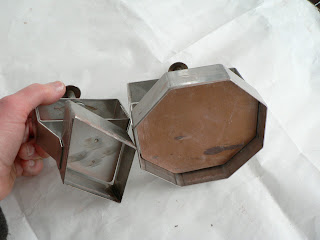Here are the tiles, hexagonal, with one little diamond one filling in the front edge space-----cut and drying on the old pieces of sheetrock (gypsum board), which had been duct-taped around the edges. I stack the sheetrock and tiles up, ending with a final board covering the tiles, so they will dry flat. Using the tile cutter also helps keep the tiles flat since I don't have to roll the tile up off of the cloth/table to release it. If I am cutting more of a puzzle-style set of tiles, I can slip the set, still on the thin sheeting, off of the piece of granite I use for a flat rolling surface, and onto a piece of sheetrock, cover with another piece of dry-ish sheetrock, and let it get to leatherhard before I do the final puzzle cutting and pulling the clay off the sheeting. (too many sheets, sheesh!)
I think I may tile the old Steelcase desk (that's Peter's, but is in my studio,) just to try out the effect. And I may also try the beeswax/mineral oil finish, which I did on a square plate, recently, instead of a glaze. (I've been looking at old French tiled floors.) I used to have the pugmill on the desk, but have moved it over to a workbench, next to the extruder, so there's not that much weight on the desk right now. Except for Paulie, now and then. Diet time for kitties.
Coming up, I'll show some images of the dies I make out of clay, for the 4" Brent extruder barrel.
Saturday, April 10, 2010
Tuesday, April 6, 2010
comment from Randy---thanks!
thanks for your idea of doing a hexagonal table, Randy (I haven't figured out how to post comments, yet, but will). I, too, while having lunch out on the porch yesterday, had a brainstorm, since I have a table base which has a triangular top, onto which I was going to put a circle top, cut from the silica-based handyboard---3/4", (not the durock cement board, 3/4 inch, with the fiberglass imbedded. ) And, quite frankly, cutting a circle is a pain, ---I have to cut a lot of straight lines and then take a tile cutter or plier and nip off the uneven parts) so--while chewing on whatever was my clean-out-the-fridge lunch, I thought, hmmm, I could simply make a lot of hex tiles, filling in the spaces along the outer edges with the diamond shaped tiles, fire them all, take the measurements, and then make a hexagonal table, which would mean that I could cut and break straight edges for the hex table, and not have to try to cut a circle! Thanks, again, to Randy,--I really believe that there are a LOT of really smart people out there, and that, together, we can figure out all sorts of things... (like health care?)
The next post will show the hex tiles, drying on old pieces of sheetrock (drywall), and then (ta da!) I will show the clay dies for my 4" Brent extruder, which I make from the same red clay I am using for the pots, fired to a cone 2, (pots and dies), out of which I can extrude edge tiles (nose tiles). I am pressed to keep on track, here, since Bruce is showing me youtube feeds on his computer that show how many potatoes can be taken out of an area (a whole truck load in three minutes),--go to Magic Valley, Idaho, and go to the 'airport', and then go to google maps, and then go to regional airport at Twin Falls.....He's doing a unit for his 5th-6th graders using Michael Pollen's The Omnivore's Dilemna. Aughhhhhhhhhhh (OK, I digress: the next post shown above will be the crop circles, for the irrigation of potatoes in Idaho)..........
The next post will show the hex tiles, drying on old pieces of sheetrock (drywall), and then (ta da!) I will show the clay dies for my 4" Brent extruder, which I make from the same red clay I am using for the pots, fired to a cone 2, (pots and dies), out of which I can extrude edge tiles (nose tiles). I am pressed to keep on track, here, since Bruce is showing me youtube feeds on his computer that show how many potatoes can be taken out of an area (a whole truck load in three minutes),--go to Magic Valley, Idaho, and go to the 'airport', and then go to google maps, and then go to regional airport at Twin Falls.....He's doing a unit for his 5th-6th graders using Michael Pollen's The Omnivore's Dilemna. Aughhhhhhhhhhh (OK, I digress: the next post shown above will be the crop circles, for the irrigation of potatoes in Idaho)..........
Monday, April 5, 2010
tile cutters
I recently bought another tile cutter from Georgie's--a hexagonal one, and am cutting tiles for tables with it. Because the plunger plate is metal, I usually add a piece of luann plywood which I glue to the face plate, and which then makes the release of a wet clay tile easier. The first tile cutter I had (4 inch square--from back in the '70's) did not plunge the tile out beyond the frame of the cutter, so, until I glued that thin piece of wood onto the plate, I could not get the clay off. [top photo, plunged all the way out.] These are photos I used to write a letter to the helpful hints section of Ceramic Monthly. More photos of the hex cutter and drying tiles to follow.
Subscribe to:
Comments (Atom)



